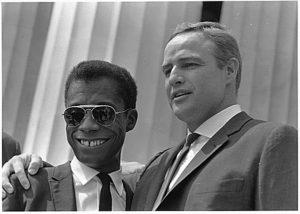For this brief post, I wish to talk about a few documentaries I have found via YouTube on the African American experience. As a surprisingly memorable Black History Month comes to a close, it is important to think about what we as historians and instructors in the classroom can use for both research and teaching tools. There is plenty in these documentaries that should interest us as both historians of the United States and of intellectual discourse in the nation’s history. Remember: they are only a sampling of what is available via YouTube, not to mention other streaming services that your college or university (if you happen to be a student or professor at one) has access to through its library.
“The Black Woman”—this documentary from 1970, part of the long-running Black Journal television series, features several important activists and artists from the era. Among other highlights are an interview between poet Nikki Giovanni and actress Lena Horne. The two discuss the then-ongoing saga of Angela Davis. The debate at the start of the show about black liberation is also illuminating, showing both the impact of black women on the Black Power movement, and their own conflicted emotions about the growing women’s liberation movement.
—a documentary from the tumultuous year of 1968, this one features interviews with Americans across the nation grappling with racism and the legacy of American slavery. Some of the most notable parts of the documentary include a sermon at Emanuel A.M.E. Church in Charleston, South Carolina dealing with the Denmark Vesey 
slave uprising, and interviews with activist Fannie Lou Hamer and, near the end, historian and then editor of Ebony magazine, Lerone Bennett. This is part of a seven-part series
CBS did in 1968 on the issue of race in American society. It would also be important to use “How the Races Feel,” the final part of this series (and frankly, an eye-opening documentary that shows just how divided the nation was on race relations in the late 1960s), to show students how divided Americans were over issues such as Black Power, affirmative action, and white racism.
“I Am Somebody”—a documentary on the Charleston Hospital Strike of 1969, “I Am Somebody” is filled with footage of strikers and activists in Charleston, along with more well-known figures taking part in the movement. This documentary is useful because it gets across how, by the end of the 1960s, civil rights activists began to more openly tie together racism with economic justice (something that was always apparent to anyone in the movement, but was taken to a new level after Martin Luther King, Jr.’s attempt at a Poor People’s Campaign). The best part of this documentary may be the scene of Coretta Scott King speaking to an enraptured audience—showcasing her leadership after death of Dr. King.
James Baldwin–with the release of I Am Not Your Negro, it’s a good time to look back at two documentaries featuring Baldwin when he was still alive. Take This Hammer is about Baldwin on a visit to San Francisco, and his experiences talking to African Americans on the West Coast. Done in 1963, the doc emphasizes that African Americans faced racism everywhere, not just in the American South. Nearly twenty years later, Baldwin was both producer and host of I Heard it Through the Grapevine, a retrospective on the Civil Rights Movement. Made before Eyes on the Prize or other documentaries on the Civil Rights Movement, this one brings home both the legacy of the movement and the problems of racism in American society that remained virtually untouched by it.
There’s plenty more available online, but I hope you check these out—as both teaching tools and primary sources.

2 Thoughts on this Post
S-USIH Comment Policy
We ask that those who participate in the discussions generated in the Comments section do so with the same decorum as they would in any other academic setting or context. Since the USIH bloggers write under our real names, we would prefer that our commenters also identify themselves by their real name. As our primary goal is to stimulate and engage in fruitful and productive discussion, ad hominem attacks (personal or professional), unnecessary insults, and/or mean-spiritedness have no place in the USIH Blog’s Comments section. Therefore, we reserve the right to remove any comments that contain any of the above and/or are not intended to further the discussion of the topic of the post. We welcome suggestions for corrections to any of our posts. As the official blog of the Society of US Intellectual History, we hope to foster a diverse community of scholars and readers who engage with one another in discussions of US intellectual history, broadly understood.
Robert: Thanks so much for these! I so wish I was teaching this term, or in the near term, so that I could use these. I love making liberal use of documentaries, in class, to supplement out-of-class reading and in-class discussions. – TL
Completely agreed. They do so much to get people in class talking. I also think they just bring history to life, reminding students that these people aren’t just names on a page.